Gordie Howe

Gordie Howe Tribute | 1928-2016
A look back at some of the great moments of Gordie Howe’s life & career with the Red Wings and hear from Jack Adams, Wayne Gretzky, and Steve Yzerman.
Gordie Howe Hockey Hall of Fame, 1972
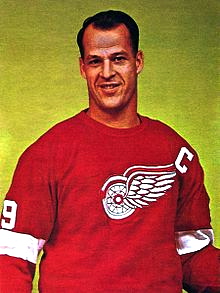 Gordon “Gordie” Howe, OC (March 31, 1928 – June 10, 2016) was a Canadian professional ice hockey player. From 1946 to 1980, he played twenty-six seasons in the National Hockey League (NHL) and six seasons in the World Hockey Association (WHA); his first 25 seasons were spent with the Detroit Red Wings. Nicknamed “Mr. Hockey”, Howe is considered one of the greatest ice hockey players of all time. A 23-time NHL All-Star, he held many of the sport’s scoring records until they were broken in the 1980s by Wayne Gretzky. He continues to hold NHL records for most games and seasons played.
Gordon “Gordie” Howe, OC (March 31, 1928 – June 10, 2016) was a Canadian professional ice hockey player. From 1946 to 1980, he played twenty-six seasons in the National Hockey League (NHL) and six seasons in the World Hockey Association (WHA); his first 25 seasons were spent with the Detroit Red Wings. Nicknamed “Mr. Hockey”, Howe is considered one of the greatest ice hockey players of all time. A 23-time NHL All-Star, he held many of the sport’s scoring records until they were broken in the 1980s by Wayne Gretzky. He continues to hold NHL records for most games and seasons played.
Howe was recruited by the Red Wings and made his NHL debut in 1946. He led the league in scoring each year from 1950 to 1954, then again in 1957 and 1963. He ranked among the top ten in league scoring for 21 consecutive years, and set a league record for points in a season (95) in 1953. He won the Stanley Cup with the Red Wings four times, won six Hart Trophies as the league’s most valuable player, and won six Art Ross Trophies as the leading scorer.
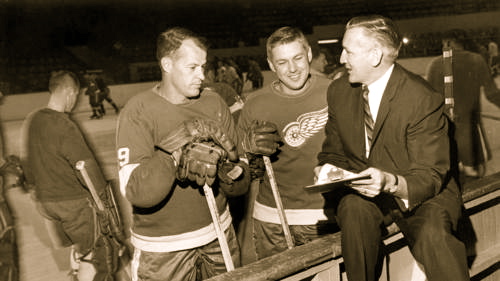 Gordie Howe, left, and Alex Delvecchio listen to instructions from Detroit Red Wings Coach Sid Abel during practice on Sept. 8, 1962. (Bruce Bennett)
Gordie Howe, left, and Alex Delvecchio listen to instructions from Detroit Red Wings Coach Sid Abel during practice on Sept. 8, 1962. (Bruce Bennett)
Howe retired in 1971 and was inducted into the Hockey Hall of Fame the next year. However, he came back two years later to join his sons Mark and Marty on the Houston Aeros of the WHA. Although in his mid-40’s, he scored over 100 points twice in six years. He made a brief return to the NHL in 1979–80, playing one season with the Hartford Whalers, then retired at the age of 52.
Howe was most famous for his scoring prowess, physical strength and career longevity. He is the only player to have competed in the NHL in five different decades (1940’s through 1980’s). Although he only achieved the feat twice in his own career, he became the namesake of the “Gordie Howe hat trick”: a goal, an assist and a fight in the same game. He was the inaugural recipient of the NHL Lifetime Achievement Award in 2008.
Early Life
Howe was born in a farmhouse in Floral, Saskatchewan, the son of Katherine (Schultz) and Albert Howe. He was one of nine siblings. When Gordie was nine days old, the Howes moved to Saskatoon, where his father worked as a labourer during the Depression. In the summers, Howe would work construction with his father.
He was mildly dyslexic growing up, but was physically beyond his years at an early age. Already six feet tall in his mid-teens, doctors feared a calcium deficiency and encouraged him to strengthen his spine with chin-ups. He began playing organized hockey at eight years old. Howe quit school during the Depression to work in construction, then left Saskatoon at sixteen to pursue his hockey career.
Playing Career
Howe was an ambidextrous player, one of just a few skaters able to use the straight sticks of his era to shoot either left- or right-handed. As a young teen Howe played bantam hockey with the King George Athletic Club in his hometown of Saskatoon, winning his first championship with them in the 1942 Saskatchewan Provincial Bantam Hockey Finals. He received his first taste of professional hockey at age 15 in 1943 when he was invited by the New York Rangers to their training camp held at “The Amphitheatre” in Winnipeg, Manitoba. He played well enough there that the Rangers wanted Howe to sign a “C” form which would have given that club his NHL rights and to play that year at Notre Dame, a Catholic school in Wilcox, Saskatchewan, that was known for turning out good hockey players. Howe did not feel that was a good fit for him and wanted to go back home to play hockey with his friends, and declined the Rangers’ offer and returned to Saskatoon.
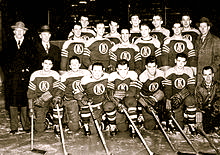 Gordie Howe (2nd from left, back row) on the 1945-46 Omaha Knights (USHL)
Gordie Howe (2nd from left, back row) on the 1945-46 Omaha Knights (USHL)
In 1944, Howe was noticed by Detroit Red Wings scout Fred Pinkney and was invited to their camp in Windsor, Ontario. He was signed by the Red Wings to a “C” form and assigned to their junior team, the Galt Red Wings. However, due to a maximum number of Western players allowed by the league and the Red Wings’ preference to develop older players, Howe’s playing time with the team was initially limited. In 1945, however, he was promoted to the Omaha Knights of the minor professional United States Hockey League (USHL), where he scored 48 points in 51 games as a seventeen-year-old. While playing in Omaha, Frank Selke of the Toronto Maple Leafs organization noticed that Howe was not properly listed as Red Wings property. Having a good relationship with Detroit coach Jack Adams, he notified Adams of the clerical error and Howe was quickly put on the team’s protected list.
Detroit Red Wings
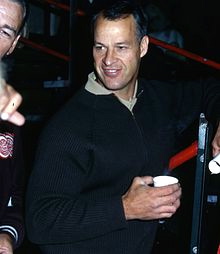 Howe relaxing at “Gordie Howe Hockeyland” in St. Clair Shores, Michigan, circa 1966
Howe relaxing at “Gordie Howe Hockeyland” in St. Clair Shores, Michigan, circa 1966
Howe made his NHL debut on October 16, 1946, playing right wing for the Detroit Red Wings, scoring in his first game at the age of 18. He wore #17 as a rookie. However, when Roy Conacher moved on to the Chicago Black Hawks after the 1946–47 season, Howe was offered Conacher’s #9, which he would wear for the rest of his career; although he had not requested the change, Howe accepted it when he was informed that “9” would entitle him to a lower Pullman berth on road trips. He quickly established himself as a great goalscorer and a gifted playmaker with a willingness to fight. Howe fought so often in his rookie season that coach Jack Adams told him, “I know you can fight. Now can you show me you can play hockey?” The term “Gordie Howe hat trick” (consisting of a goal, an assist, and a fight) was coined in reference to his penchant for fighting; however, Howe himself only recorded two such hat tricks in his career, on October 10, 1953, and March 21, 1954. Using his great physical strength, he was able to dominate the opposition in a career that spanned six decades (including one game with the Detroit Vipers of the IHL in 1997). In a feat unsurpassed by any hockey player, he finished in the top five in scoring for 20 straight seasons. Howe also scored 20 or more goals in 22 consecutive seasons between 1949 and 1971, an NHL record.
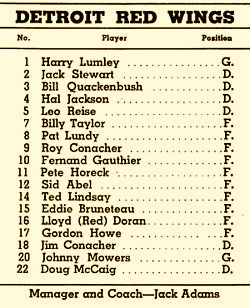 Although famous as #9 during his long career, 18-year-old Gordon Howe actually wore #17 throughout his rookie season with the Detroit Red Wings in 1946–47.
Although famous as #9 during his long career, 18-year-old Gordon Howe actually wore #17 throughout his rookie season with the Detroit Red Wings in 1946–47.
Howe led Detroit to four Stanley Cup championships and to first place in regular season play for seven consecutive years (1948–49 to 1954–55), a feat never equaled in NHL history. During this time, Howe and his linemates, Sid Abel and Ted Lindsay, were known collectively as “The Production Line”, both for their scoring and as an allusion to Detroit auto factories. The trio dominated the league in such a fashion that in 1949–50, they finished one-two-three in league scoring. Howe had been in his prime during a defensive era, the 1940’s and 1950’s, when scoring was difficult and checking was tight.
As his career just started going, however, Howe sustained the worst injury of his career, fracturing his skull after an attempt to check Toronto Maple Leafs captain Ted Kennedy into the boards went awry during the 1950 playoffs. The severity of the fracture was such that he was taken to the hospital for emergency surgery in order to relieve building pressure on his brain. The next season, he returned to record 86 points, winning the scoring title by 20 points.
As Howe emerged as one of the game’s superstars, he was frequently compared to the Montreal Canadiens’ Maurice “Rocket” Richard. Both were right wingers who wore the number 9, were frequently contenders for the league scoring title, and could also play rough if needed. During their first encounter in the Montreal Forum, when Howe was a rookie, he knocked Richard out cold with a punch after being shoved. The Red Wings and Canadiens faced off in four Stanley Cup finals during the 1950’s. When Richard retired in 1960, he paid tribute to Howe, saying “Gordie could do everything.”
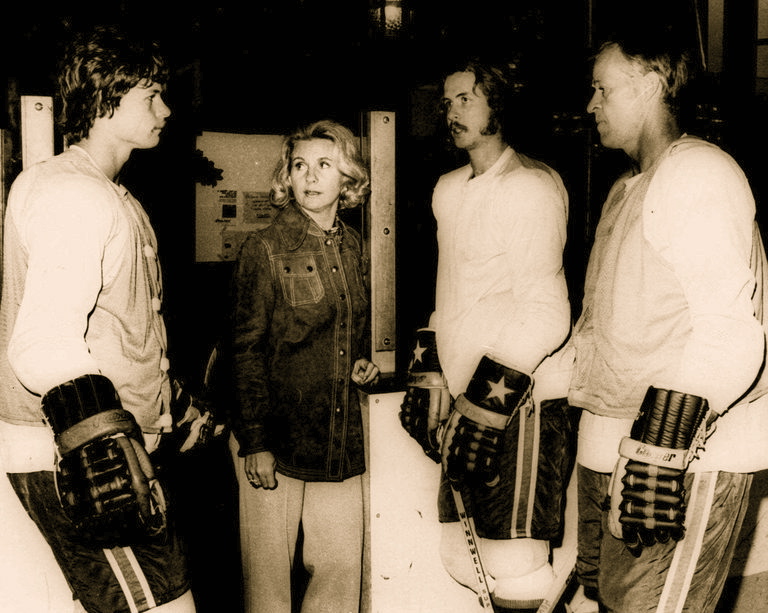 From left, Marty, Colleen, Mark and Gordie Howe during a practice of the Houston Aeros in 1974. Credit Associated Press
From left, Marty, Colleen, Mark and Gordie Howe during a practice of the Houston Aeros in 1974. Credit Associated Press
The Red Wings were consistent contenders throughout the 1950’s and early 1960’s, but began to slump in the late 1960s. When Howe turned 40 in 1967–68, the league expanded from six to 12 teams and the number of scoring opportunities grew as the game schedule increased. Howe played the 1968–69 season on a line with Alex Delvecchio and Frank Mahovlich. Mahovlich was big, fast, and skilled, and Delvecchio was a gifted playmaker. The three were dubbed “The Production Line 3” and at 40 years old, Howe reached new scoring heights, topping 100 points for the only time of his NHL career with 44 goals and a career-high 59 assists.
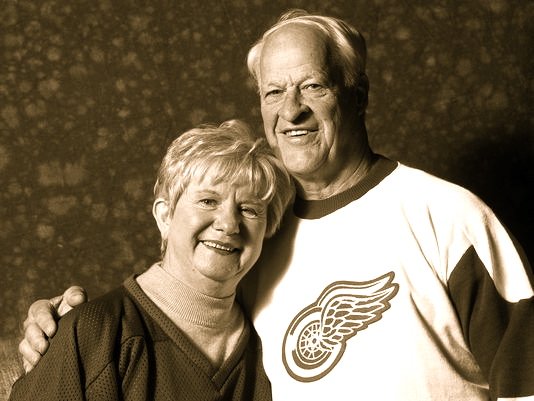 (Photo: The Detroit News archives)
(Photo: The Detroit News archives)
Following his personal best 103-point season, however, conflict with the Red Wings organization arose after Howe discovered he was just the third-highest paid player on the team with a $45,000 salary. Furthermore, while owner Bruce Norris increased Howe’s salary to $100,000, he blamed Howe’s wife, Colleen, for the demand. Howe remained with the Red Wings for two more seasons, but after 25 years, a chronic wrist problem forced him to retire after the 1970–71 season and he took a job in the Red Wings front office. At the beginning of 1972, he was offered the job as first head coach of the New York Islanders, but turned it down. By the end of his NHL career, Howe had won the Hart Memorial Trophy as the NHL Most Valuable Player six times: 1952, 1953, 1957, 1958, 1960, and 1963—at that time the most of any player, and as of 2016 second only to Gretzky’s nine. Howe was named an Officer of the Order of Canada in 1971. His number 9 jersey was retired by the Wings on March 12, 1972.

